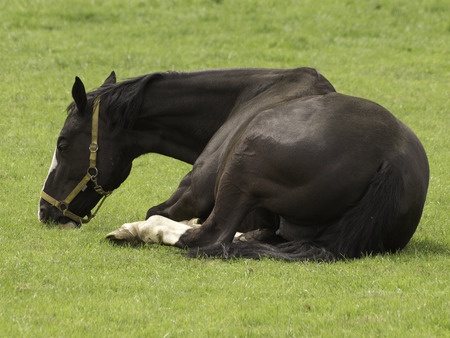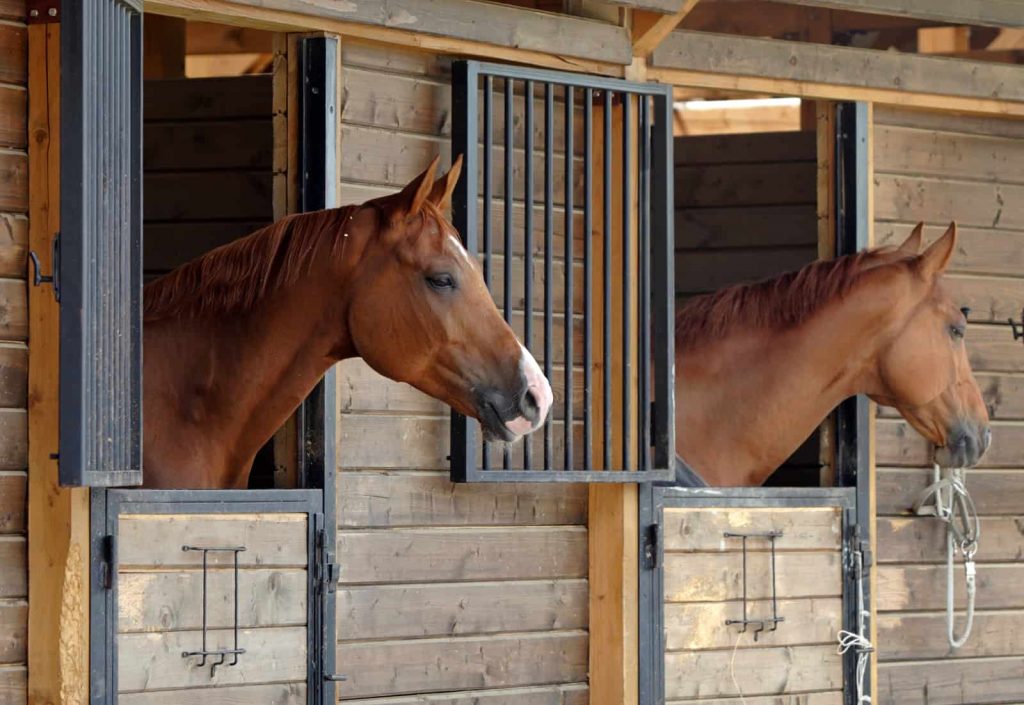
5 of the Best Ways to Celebrate Halloween with your Horse
October 31, 2020
ThinLine Flexible Filly Grazing Muzzle Review
November 28, 2020What you need to know about Colic in Horses
What you as a horse owner need to know about Horse Colic
We can’t deny that colic in horses is an alarming topic, but avoiding the subject will not stop it from happening. And realistically, there is a good chance that it will happen to your horse throughout his or her lifetime.
As we get deeper into fall and transition into winter, we will see more cold fronts passing through. One key cause of colic in horses is drastic changes in temperature, and leaving one season behind and moving into another one can demonstrate these changes.
What is Colic in Horses?
Colic, by definition, is any abdominal pain that your horse may encounter. Despite this, horse owners typically refer to colic as problems with the gastrointestinal tract. Colic is quite often unpredictable, and usually unpreventable.
Based on their anatomies, horses are naturally prone to colic. Fortunately, over 80 percent of colic episodes respond well to treatment when identified early and with quick reaction on the caretaker’s part. Communicating behavioral changes to your veterinarian at the onset of any noticed pain or discomfort is vital to keeping colic from escalating.

Causes and Symptoms
There are several reasons your horse may be affected, but generally, they are related to the anatomy and the microflora of the horse’s gastrointestinal tract. Some of the most common reasons your horse may colic:
- High grain-based diets/Low forage diets
- Moldy/tainted feed
- An abrupt change in feed
- Stress (which can be caused by many external influences)
- Parasite infestation
- Lack of water consumption, which can lead to impaction colic
- Sand ingestion
- Non-steroidal anti-inflammatory drugs (NSAIDs)
- Dental problems, including bad teeth and sharp points and edges that prevent your horse from chewing correctly
- Antibiotics. Antibiotics may change the gut’s microbial population, causing implications to your horse’s starch digestion
How do you tell if your horse is colicking? - Common signs of a Colic problem
- Pawing
- Rolling
- Staring at the flank region
- Bloating
- Sweating
- Biting
- Distress or restlessness (such as getting up and down)
- Uneasiness
- Loss of interest in food and water (Loss of appetite)
- Peculiar postures (sitting, stretching)
- Absence of gut sounds
- A high heart and respiratory rate
- Flared nostrils
Also, note that a colicking foal does not always show typical signs of colic as you would expect from a mature horse. Rather, they may lay on their back with their hind legs tucked in. The best mechanism is to be on alert for any unusual behavior from the foal and contact your veterinarian.
Common Types of Colic in Horses
There are many types of colic, which your horse may or may not have. Let’s take a look at the most common types of a colic implication.
Stomach distention: The small capacity of the horse’s stomach makes it susceptible to distension when large amounts of grain are ingested in a single meal or sitting. In other words, this type of colic would suggest the horse has overeaten and is feeling too full. In a human, this would be classed as feeling ‘bloated’.
Displacement colic: The small intestines are suspended by the mesentery’s abdominal cavity and float freely around the gut. This mobility can predispose the small intestine to become twisted and, therefore, causing abdominal pain and issues.
Impaction colic: The large intestine folds upon itself and has several directions (flexures) and diameter changes.
Gas colic: All colics are associated with some gas build-up within the abdominal system. Gas can accumulate in the stomach and the intestines. As gas builds up, the gut distends, causing abdominal pain to the horse. Bacteria can produce excessive gas in the heart after ingesting large amounts of grain or moldy feeds.
Spasmodic colic: By definition, spasmodic colic’s are painful contractions of the soft muscle tissue in the intestines. Over excitement can trigger spasmodic horse colic. In short, this is over-activity of the gastrointestinal tract and can often go away untreated, although it’s always safe to get this checked.
Enteritis: Usually, this is inflammation of the small intestine, possibly due to bacteria, grain overload, or spoiled feed. Horses with enteritis may also have diarrhea, which is a common symptom of enteritis.
Colic Treatment and Remediation
The best course of action is to contact your veterinarian early and provide initial treatment under your veterinarian’s direction. You can begin to document observations to help your veterinarian with an informed treatment course.

While waiting for your veterinarian, here are some best practices to ensure your horse is as safe and comfortable as possible.
- Observe your horse and monitor vital signs as well as the passing of any feces
- Remove access to feed and hay. If there is a blockage, any feed or hay intake will only intensify the problem
- Make sure their water is fresh and accessible
- Allow your horse to rest as much as possible. It is not necessary to walk horses unless they are rolling. It is fine for them to lay down, but you want to watch to make sure they are not rolling.
- Do not administer any medication without the direction of the attending veterinarian. If you were to administer pain medication, it may mask the colic symptoms and complicate diagnosis, and possible treatment
Only based on your veterinarian’s direction, you may also want to be ready to respond by having supplies on hand. These may include:
- Banamine (intravenous works faster, but the tube is safer if you have staff or family that can not safely administer an IV injection)
- Sedative
- Ulcergard or Gastrogard tubes (or equivalent)
- Oral electrolytes tubes
- Other medications (per your veterinarian)
One best practice is to inventory your stock and expiration dates of all medications at the same time when you undergo semi-annual vaccines.
What your veterinarian may do
Upon arrival, your veterinarian will listen for gut sounds, monitor vital signs, pass a nasogastric tube through the nasal cavity of your horse to evaluate stomach contents or to oil your horse, and perform a rectal exam. Most of the time, you can relieve and treat the colic in the barn where the horse resides with medication and the use of a nasogastric tube to alleviate gas and administer medications. However, if the veterinarian suspects a displacement or an imperfection within your horse that can’t be successfully treated on-site, he/she will refer you to an equine surgical hospital for further analysis, IV fluids, or surgery.
Even after treatment, your veterinarian should discuss the colic protocol for observation and feeding for the next few days. This will likely impact hay rations, feed rations, turnout, and exercise. You will want to continue to observe the horse closely as well as medicate according to the veterinarian’s recommendations.
Equine Simplified allows you to keep records on all medication and horse health progress, so you can quickly show to your vet for better treatment. Try us now, free for 15 days!

How to prevent colic in horses
Even the best programs will still see horses that colic. However, you can take preventative measures to avoid or to minimize the frequency and number of cases in your barn. Some preventative measures are as follows:
- Feed your horse on a regular schedule; horses need a regular frequency
- Do not make sudden changes to the horse’s diet. All changes should be over 7-14 days
- When getting a new load of hay, blend hay for ~7 days to reduce stress to your horse’s system
- Keep a clean, freshwater supply for your horse
- Keep feeders and hay racks clean and free of mold and dust
- Check teeth frequently for dental problems that may cause chewing issues
- Practice an effective parasite control program that fits your farm’s needs
- Document each horses’ behavioral and physical characteristics when they colic. This can help you predict future episode earlier and thus respond with earlier treatments
Conclusion
Knowing your horse’s regular behavior and identifying any deviation are key to early diagnosis of colic. Additionally, recognizing that the change of seasons certainly can trigger colic, now is the time to prepare. Having a plan with strong observations and communication with your veterinarian is key to addressing early and perhaps minimizing the impact.
One of the benefits of Equine Simplified is tracking health observations and vitals so that you can communicate details with your veterinarian. It also gives you a log of treatments so that you can develop baseline diagnosis for behaviors noted when your horse colics and what treatments work.
References
https://equimed.com/diseases-and-conditions/reference/colic-spasmodic
https://eliteequineuk.com/2020/01/09/colic-101/

